UPDATED REVIEW – February 22, 2015 – Casio Privia PX750 Digital Piano – This model is now discontinued and replaced by the new PX760 – Go to the following link to read about the brand new PX760 and why it is a better instrument in a few important ways and worth getting over the discontinued PX750: Casio PX760 review
Previous review of the PX750: I recommend the Casio Privia PX750 digital piano ($799 internet discount price which includes the furniture stand and 3 pedals) because it offers a surprisingly realistic upright piano playing experience in a very low price range for both key action movement, acoustic piano tone realism, and pedaling in a sleek compact furniture style cabinet (with a metal sliding key cover) available in satin black, satin oak brown, & satin white finishes.
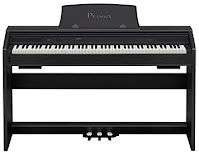 |
| Casio PX750 black |
Overall, the PX750 is the same piano as the PX150 portable model as far as key action and functions except that the PX750 projects the piano sound in a much better way through upgraded speakers producing a fuller, more resonate piano tone. Also, the PX750 has a more elegant compact furniture style cabinet with a sliding metal key cover (none on the portable models) which helps protect the key mechanism from dust & dirt, and comes with the matching stand and 3-pedal unit as opposed to it being optional. The PX750 is fairly lightweight with stand and pedals (only 71lbs), and the piano itself can be detached from the stand & pedals for easy moving. A couple of other things worth noting about this model as compared with portable digital pianos is the fact that there is room on top of the piano (because of its design) to put things on like music or other items. This is because the speakers are underneath the piano facing forward as opposed to being on top of the piano as they are in the portable models. The piano top itself is also taller than the portables which allows for front facing controls on the control panel (see pictures) which are convenient to use as opposed to the portables which are not built in that way. So really there is a lot to like about this model as opposed to any of the more basic portable pianos including the Casio PX150, Yamaha P105, and others like them, and the PX750 is only slightly more money.
The Casio company itself is based in Tokyo, Japan (left pic) and has been producing digital pianos and musical instruments including digital keyboards, synthesizers, pianos, guitars, and other sophisticated musical instruments for over 30 years, which is a long time in my opinion. They are obviously also well known for their keyboards, watches, digital cameras, calculators, and hundreds of other digital products so technology is not new to them. Casio is generally thought of as a company that gives you a lot of “bang for the buck” in the lower price ranges and it’s certainly true for the PX750 in my opinion as compared to any other brand in this price range. By the way, all Casio digital pianos come with a long 3 year parts and labor factory warranty, and are fairly reliable based on my personal experience as well as other people I know who own Casio pianos, so there is little reason to buy extended warranties for these pianos.
| PX750 |
I have played the PX750 many times and I like the way the PX750 plays and sounds. It has 18 instrument tones, five of which are various acoustic piano sounds which is one of the most important features to have on a digital piano. The other sounds are a mix of strings, organs, harpsicord, and electric pianos. Those particular instrument sounds are just average and don’t really sound like those actual instruments. However, a good variety of acoustic piano tones allows you to play and reproduce different types of piano music including classical, jazz, pop, country, etc. There are a few digital pianos from other brands available in lower prices ranges including the Yamaha, but they typically have only two acoustic piano sounds. So having five of them on the Casio is very good. The PX750 has 128-note polyphony as opposed to 64 notes in many other digital pianos in this price range and that allows the player to play more complex music or have two sounds layered together with no notes dropping out because of lack of polyphony processing power. It’s generally always good to get more polyphony rather than less and having more polyphony also helps with pedal sustain ability when sustaining multiple notes on the
keys. Playing the pedals is a very important aspect of piano playing
and this would include having good pedal sustain instead of just on & off sustain as is in other digital pianos and keyboards. The more realistic pedal sustain reproduction is also known as “half-pedaling,” and this Casio PX750 has that feature which is important as your playing skill level increases. All regular acoustic pianos have a “gradual or incremental sustain” triggered by the right pedal, so getting “half-pedal” sustain on your digital piano is a very good thing.
As far as key action movement and dynamic response goes, the PX750 is surprisingly realistic (feels pretty much like an upright piano) for its low price and I was impressed when I played it especially in this lower price range. Key action is always the number one concern of piano teachers and those people that can play piano at higher skill levels. People always ask me “does this digital piano feel and respond like a real acoustic piano?” My answer is always that most brands and models of real acoustic pianos feel and play differently from each other including uprights & grands. There are different price ranges and qualities just like in anything you can buy, so the PX750 is not going to be replacing a Steinway grand piano anytime soon! However, for its price range it is an exceptional piano in being able to get close to an acoustic piano playing experience with proper tonal dynamics, smooth volume response, and fairly good decay and attack times (this means what a piano sounds like when you first press the key down and then release it while holding the damper sustain pedal).
 |
| PX750 satin white |
As far as the piano keys themselves go, the better digital manufacturers have come out with a new synthetic “ivory feel keytop” on many digital pianos which is a new material on top of the white keys that tries to reproduce the original real ivory keys that used to be on most acoustic pianos many years ago until it became illegal to use elephant ivory. The ivory substance provided a better playing experience for most people because it absorbed sweat your fingers would produce while playing the keys and this material also provided a smoother key surface as well. Also, the black key tops were made of ebony (have you heard the term ebony & ivory?) so the black keys also had a better playing surface. To get these new keytops instead of the regular plastic ones, you would need to spend more money on other brands to get it on digital pianos these days. Beyond that, this new material is not the same on different piano brands because some are noticeably better than others. Casio has added a proprietary synthetic ebony and ivory to their keys that I do like, but it does take a bit of getting used to for some people.
Beyond the piano playing experience, having some useful digital features in the piano that can help with music education and/or playing skills, etc, is always welcome as far as I’m concerned. As a piano teacher & musician I enjoy having these things on my digital pianos and like to see students and recreational piano players get them too. The PX750 allows for layering two sounds together like acoustic piano and string violins etc, electronically splitting the keyboard into 2 equal parts for duet play for teaching and learning, or to put a different sound on the left hand and a different sound on the right hand which is lots of fun. The PX750 also has a USB MIDI “plug & play” connection to computer or iPad device which is very useful for interactive play and learning and there are super cool iPad/tablet apps out there to take advantage of this new technology as well as great piano music programs for laptop computers so that you can have a fun interactive time in learning, composing, on screen notation & music creation. The PX750 also has other useful features such as a built in electronic metronome for timing, 2 headphone jacks for private playing, touch response adjustments for the reaction of the key volume to your touch, special reverb echo effects, and a classical music library for playalong. To use some of these extra functions, you need to look at a operational menu in the owners manual because there is no display screen on the piano, but this is true for the other name brand digital pianos in this price range.
| PX750 with key cover closed |
Overall for the money, the Casio PX750 is by far the best furniture style digital piano out there under $800 that reproduces the piano playing experience in a way that makes it seem real…and that’s what it’s all about. Is this piano a concert grand or a big upright piano?…no…not even close and you shouldn’t expect that. Although the PX750 piano is lightweight and the top can come off the stand, it is not meant to be portable to be played apart from the stand & pedals. So if you want to take it places, then you should look at the portable PX150 version instead, or another brand & model of portable piano.
 |
| Casio PX780 |
There is also a better Casio piano in a slightly higher price range with built-in digital educational technology and LCD user display screen to help with “learning and playing fun” and it has some very cool added features on it along with the same piano key action & piano realism of the Casio PX750. That model is called the PX780 (above left pic) with an internet discount price of $999, and it also sounds much bigger & fuller than the PX750 because of its 40 watt 4-speaker internal sound system as compared to 16 watts and 2 speakers in the PX750. The PX780 is my pick for “best bang for the buck” of any new digital piano selling for under $1000. You can find more info on this model by reading my review: Casio PX780 Review
| PX750 |
The only other brand out there in this price range with a furniture style cabinet I would recommend in a lower price range is Yamaha, but as of right now their lowest price cabinet piano is the YDP142 ($1099 internet price) and it doesn’t come close to the Casio PX750/PX760 or the PX780 in terms of piano realism and features. When you add up its 128-note polyphony, upright key graduated hammer key action, synthetic ivory & ebony key tops, “half-pedal” sustain feature, and front facing panel controls, as well as USB to iPad/computer output, you get a lot for a small price. However, once you get above the $1000 price range there are certainly more options out there (like Roland & Kawai). The Yamaha YDP142 is a nice instrument but it’s the same price as the brand new upgraded Casio PX860 ($1099 internet price), and the Casio PX860 is substantially upgraded over the Casio PX750 and the Yamaha. For now, the Privia PX750 (now replaced by the new PX760) or PX780 would be my choice for contemporary cabinet pianos in the lower price range under $1000. But for slightly more money the new top of the line Casio Privia PX860 is also an impressive instrument and a big upgrade over the PX750 as I just mentioned. Go here for the PX860 review: Casio PX860 review
If you want more info on these and other pianos and lower prices than internet or store discounts, please email me at tim@azpianowholesale.com or call me direct at 602-571-1864.
* I recommend eMedia educational software. If you decide to make a purchase after clicking on link below, I have arranged a big discount for you direct with eMedia for their educational software and that discount price is displayed through this link only! I want to see everyone learn to play and enjoy piano!
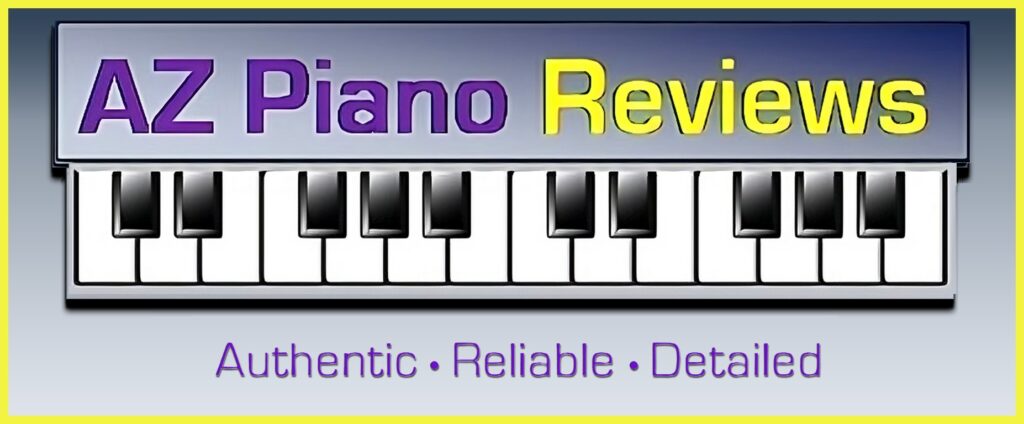








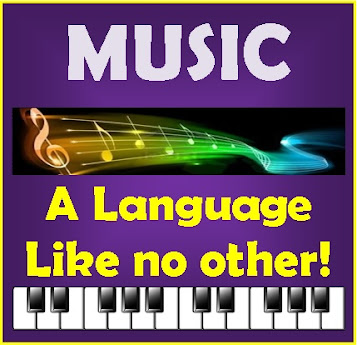

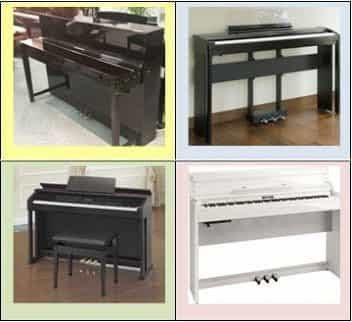
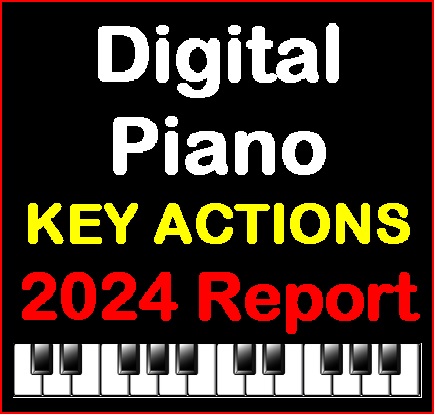
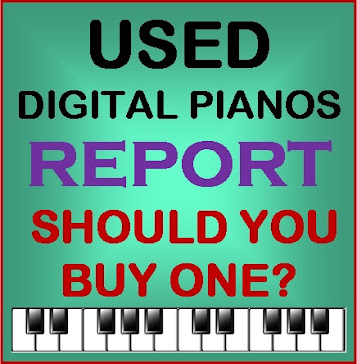
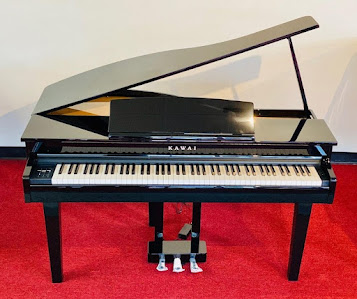
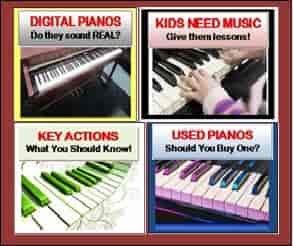
Thank you so very much for this blog! My daughter has been playing piano for 3½ years on a keyboard that I bought for less than $100 bucks. I've actively looking for the next level for over a year now. This sounds like the perfect upgrade for her without spending a fortune. Great video demonstration too!
Thanks for your comments. If you would like more info on this or other digital pianos or want to know how to get new digital pianos for less than internet prices, then please email me direct and I will share that info with you.
Any idea where I can buy this from in the UK? It's on amazon for £699 which is $1125, much more expensive than in the US!
Thank you so much for this article. I lost an ebay auction for the px-130, I believe this was a blessing in disguise, because for just a few hundred dollars more I just ordered the px-750 with all furniture and foot-board, great article – Thanks again
>>>
Playing the pedals is a very important aspect of piano playing and this would include having gradual sustain reproduction instead of just on & off sustain as is in so many other digital pianos. Gradual sustain is also known as "half-pedaling," and this Casio PX750 has that feature which is important as your playing skill level increases.
<<<
Does the PX-750 has real "gradual sustain", or does it have a 3-position damper pedal —
. . . dampers on;
. . . dampers half-on;
. . . dampers off.
I ask because my PX-350 has a "half-pedal" feature, but it's not "gradual".
Thanks — Charles
This is all new to me and I just started looking for my 10 year old who is starting lessons. Our local music store says to be sure to get weighted keys like a piano… does the PX-750 have? Since she is young and just starting (soon) would the PX-150 or the PX-750 be the way to go? We dont even know if she will stick with it. Thanks.
Thanks for this very useful review. Could you please tell me, how solid is the PX750 as a piece of furniture, especially compared to the AP750? I am concerned that the lack of a solid back would make it wobble when played hard.
Thanks — Marc
I have not had that issue when playing the PX750. It also depends on the kind of floor it sits on.
Thanks for your reply. By the way, I meant compared to the AP-220, which you now recommend against, in favor of this PX-750. I am really torn between these two models. From pictures on the internet, I prefer the look of the AP-220: it looks much more like a piece of furniture, compared to the PX-750, which looks more like a keyboard on a stand. Do you agree, as someone who has seen them in person?
I am a complete beginner to the piano, and to playing music in general (currently learning Frère Jacques on a 3 octave keyboard!). Do you think someone like me is going to notice the difference in the new ebony/ivory keys, or the new AiR electronics?
Thanks — Marc
The new Casio AP250 is the replacement for the AP220 and has the more traditional cabinet. The AP250 sound and key action is noticeably upgraded over the older AP220 technology. The AP250 is $200 more than the older AP220 but the difference in price is well worth it in my opinion, especially if you plan on keeping it for a long time. Please email me for more details including how to buy the pianos for less money
Thanks for your extremely useful reviews Tim. I was just about to buy a Casio Privia PX 735 but, after reading your commets, I am wondering if it isn´t a better option to wait until the PX 750 is available in Argentina (I haven´t seen it here yet). I will wait for your advice to make my decision.
Thanks in advance,
Jorge
Jorge,
I would definitely recommend for you to wait on the Casio PX750 as it is MUCH better in piano realism and playing experience than the older PX735. Adios y buena suerte, Amigo
Hi I'm going to by a digitalpiano and have been looking at the Casio Privia PX-750 and read your review the price in sweden is $1163. I've also managed to find a used Casio Cleviano AP-620 for $799 and now i don't know witch one to by and thought i should ask you!
Hi Tim
Thank you for these insightful post. Between the Casio PX-350(set up on furniture stand and three pedals) and PX750/PX780 what is the pro/cons you see in terms of quality of play experience? (I realize PX 350 is portable) And if i went with PX750/PX 780 at what point would it make more sense to buy the more expensive Yamaha Arius YDP 162. I believe each model has its sweet spot and you seem to capture it well given your experience as a player and a piano teacher. My investment horizon for this piece of equipment is 5 years. If it satisfies me without feeling like I constantly need to upgrade to the next best thing I'd be super happy.
Thank you in advance for your reply
i'm choosing to buy between this and the yamaha p-155. in your own preference, what would you pick between the 2?
These are two totally different pianos for different purposes and really should not be compared. Both are good for different reasons. They are also in different price ranges
i mean for home playing only. and i only care about the piano, not so much about other tones. but I would pick the one that has more realistic feel and sound. so base on that, what do you suggest between the two?
Hi Tim, thank you very much for The Review and Information !
But i'm still Curios the Difference between PX 750 and PX 780
is it only at speakers ? because PX 780 not Available in Indonesia, so either i stick To PX 750 or to PX 850 (which is so expensive here than the "retail" or "Amazon/Ebay" price"
thank You Very much
The PX780 is significantly upgraded over the PX750 with regard to digital features including the amount of instrument sounds, educational feature, recording, rhythms, etc, internal sound system, and connectivity. The piano sound and key action is the same between the two models although there is more variety of piano sounds on the PX780 as well as more editing of sounds to personalize what you hear. The PX780 also has the LCD display screen which makes it much easier to understand what buttons and features are being selected. The PX780 is not available in many places in the world, although it is available here in the US. The PX350 is the portable version of the PX780 and is the same as that model in every way with the exception that the PX350 does not have the upgraded internal sound system or better cabinet of the PX780, and when you add the Casio stand and 3-pedal unit to the PX350, the PX780 is not much more money and therefore it is a better purchase if portability is not needed with the PX350.
i wonder weather the simulated ivory ebony key make it easily dirty?
are this kind of key suit for little children?
Yes, the keys are good for children and I have not seen the keys have any problems with being dirty…unless you purposely play with dirt on your fingers.
Hi Tim,
After reading many of your informative reviews, thank goodness, Its down to the PX750 or the Kawai ES100 for my beginner wife?? With a slight price difference here in Australia what would you lean towards??
Thanks
Hello Tim, since you've had your time on the PX 750, do you know how to change the temperament and tuning of the 750? The manual got me confused cause i follow the directions and they don't seem to work. Thanks in advance!!
PS. It's a great entry level piano I am very satisfied with!
Its John again here. In ref to my last comment requesting for the price source. I think I might have the answer. Tim you've priovided the prices in USD. I thought its was in AUD (australia) because the website said ….com.au Please confirm if the prices are in USD or AUD? Tks again.
I always refer to new digital piano prices in US dollars
I really love reading your reviews. After not finding any relevant digital piano (in white color) 2nd hand adds (same over priced 2nd hands problem here as well), I am considering buying my daughters whom started learning to play the piano (6 yr and 9 yr) a new Casio Px-750. We went to the store today to try it out and I must say something in the keys felt very bouncy (as if something bounces inside and makes the key vibrate and jump back) and even more so in the lower tunes (the left side) is it normal? I didn't have the same feeling in other brands.
As unfortunately I'm not much of a piano player myself, it is not really a question of my personal taste but still, since the key action is a #1 consideration for me I have to ask if this bouncing isn't a sign of bad key action that may cause bad habits.
Thanks,
Amir
I understand what you are saying. On acoustic pianos, upright piano key actions don't bounce at all but grand piano key actions do bounce with some more than others. A "bouncy" key action" is not necessarily indicative of a bad key action…especially given the way real grand pianos can play. Keys are also supposed to jump back to some degree and thy do that on grand pianos depending on ho hard you strike the keys. The Casio PX750 is an excellent piano for its price an has a more natural piano key movement than many other brands.
I'm torn between Casio PX160, Casio PX760 and Yamaha P115. Realistic piano sound is my number one criteria and also the piano key action. I would like to get a decent one for my 6 year old once he starts piano lessons. What is your recommendation?